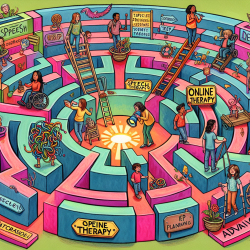Introduction
In the dynamic landscape of school-based mental health services, professionals often find themselves navigating the complexities of Individualized Education Program (IEP) planning and meetings. With the advent of technology, online therapy services have emerged as a pivotal tool in enhancing the effectiveness of these processes. By integrating telepractice into IEP planning, mental health professionals can leverage data-driven insights to foster improved outcomes for students.
The Challenge: Feeling Lost in IEP Planning
IEP planning is a multifaceted process that requires collaboration, precise data interpretation, and a tailored approach to meet each student's unique needs. However, mental health professionals often express a sense of being lost amidst the overwhelming data and the need to coordinate with multiple stakeholders. This feeling can be particularly pronounced in schools where resources are limited, and caseloads are high.
The Solution: Embracing Online Therapy Services
Online therapy services, or telepractice, offer a compelling solution to these challenges. By providing a flexible and accessible platform for therapy sessions, telepractice allows for consistent and comprehensive data collection. This data can be instrumental in shaping IEP goals and monitoring progress.
- Data-Driven Decisions: Telepractice platforms often include robust data tracking features, enabling professionals to collect and analyze information on student progress over time. This data is invaluable in making informed decisions during IEP meetings.
- Enhanced Collaboration: Online platforms facilitate seamless communication between therapists, educators, and parents, ensuring that all stakeholders are aligned and informed.
- Resource Optimization: By reducing the need for physical space and travel, telepractice allows schools to optimize their resources, making therapy services more accessible to a broader range of students.
Implementing Telepractice in IEP Planning
To effectively integrate online therapy services into IEP planning, mental health professionals should consider the following steps:
- Training and Familiarization: Ensure that all staff members are adequately trained in using telepractice tools and understand the data they generate.
- Data Integration: Establish a system for integrating telepractice data into existing IEP frameworks, ensuring that it informs goal-setting and progress monitoring.
- Regular Review: Schedule regular reviews of telepractice data with all stakeholders to assess progress and adjust IEP goals as necessary.
Conclusion
By embracing online therapy services, mental health professionals can transform the IEP planning process from a source of stress and confusion into a streamlined, data-driven endeavor. Telepractice not only enhances the ability to make informed decisions but also fosters a collaborative environment where all stakeholders are empowered to contribute to student success. As we continue to navigate the complexities of educational therapy, integrating technology into our practices is a crucial step towards achieving optimal outcomes for every child.
For mental health professionals feeling lost in the intricacies of IEP planning, the integration of telepractice offers a path forward. By leveraging data and enhancing collaboration, we can ensure that every student receives the tailored support they need to thrive.










